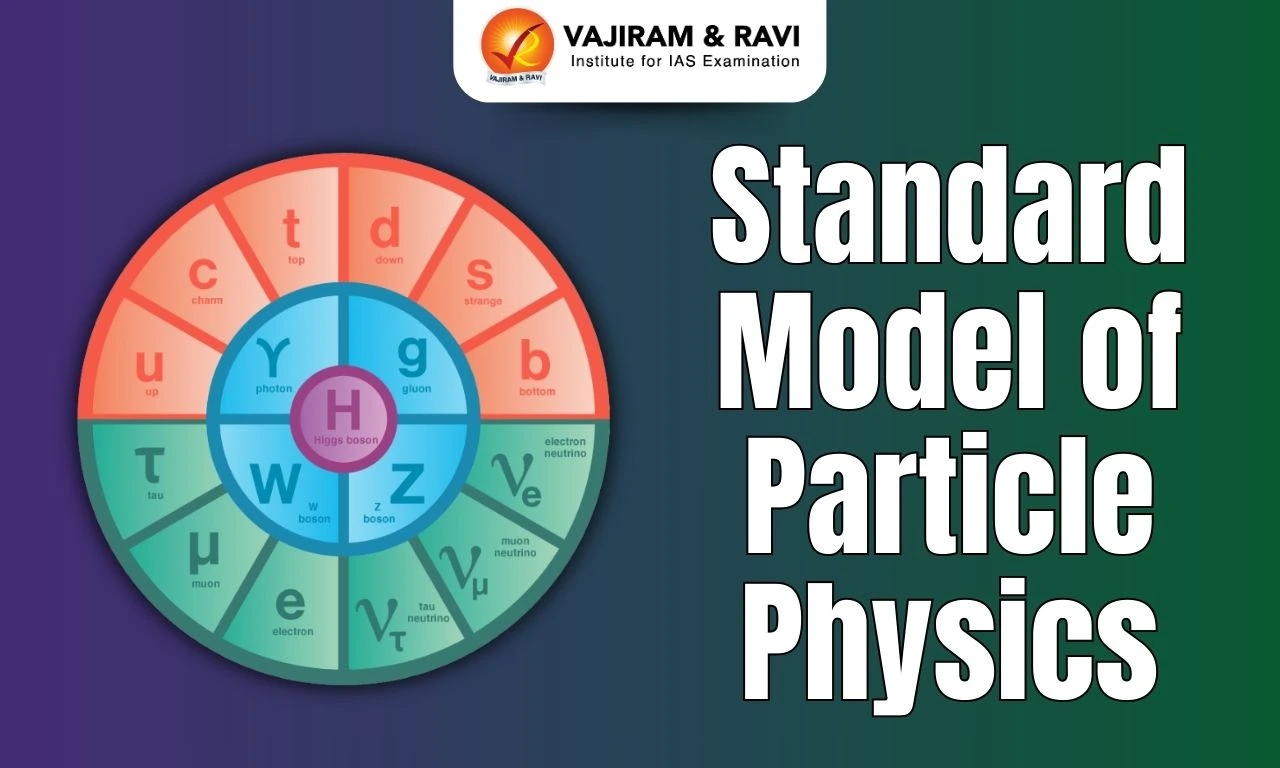The Standard Model of Particle Physics is the name given in the 1970s to a theory of fundamental particles and their interactions. All the fundamental particles can be divided depending on how they “spin” in quantum mechanical terms. Based on this, the Standard Model considers twelve fermions and five bosons so far. Fermions are the matter of particles, whereas bosons are the carriers of the fundamental forces.
The Standard Model of Particle Physics is currently the best way to describe the most fundamental building blocks of the universe.
Fundamental Particles
Atoms are made up of only three types of particles - electrons (leptons) that revolve around the nucleus, and protons and neutrons inside the nucleus. Both protons and neutrons are composite particles and are made up of fundamental particles - up and down quarks with different combinations. Thus, fermions (quarks and leptons) and bosons are the actual fundamental particles.

Fermions
Fermions are the fundamental particles of normal matter. They transfer discrete amounts of energy by exchanging bosons (carrier particles of fundamental forces) with each other.
- Characteristics:
- They obey the Pauli Exclusion Principle, that is, no two fermions (for example - electrons) can occupy the same location in space and cannot have the same quantum numbers.
- Unlike Bosons, they obey Fermi-Dirac Statistics.
- Types: Fermions are of two types namely - quarks and leptons.

- Quarks: Quarks occur in flavours and colours. There are six quarks - three generations (flavours or identities) and three colour charges.
- Combination: They combine to form composite particles, called hadrons. Baryons and Mesons are the hadrons.
- A baryon is composed of three quarks. Protons and neutrons are examples of baryons.
- A meson is composed of two quarks and becomes a boson.
- Quarks can change their identities (due to weak force via W and Z bosons) or can combine to make composite particles (due to strong nuclear force via gluons).
- Combination: They combine to form composite particles, called hadrons. Baryons and Mesons are the hadrons.

- Leptons: Leptons are also the fundamental particles but unlike quarks, they do not possess colour charges hence, do not interact with the strong nuclear force.
- There are 6 leptons - three negatively charged leptons (Electron,muon, and tauon), and three neutral (Neutrinos).
- Unlike quarks, leptons do not reside inside the nucleus.
- Unlike quarks, they do not make composite particles (as no interaction with strong nuclear force carrier).
- They cannot change their identities also.
- Neutrinos (Ghost Particles) are leptons and are the most abundant particles in the universe that have mass.
- They can be produced during nuclear fusion (as in the sun), in a nuclear reactor and radioactive decay.
- Neutrinos can change their types, through neutrino oscillation.
- Neutrino detectors around the world including the INO Project of India work towards the understanding of these particles.
Bosons
All the force carrier particles and composite particles with integer spins (mesons) are Bosons.
- Characteristics: Unlike Fermions, they do not obey Pauli’s Exclusion Principle and Fermi-Dirac Statistics.
- Instead, they obey Bose-Einstein statistics as described by Satyendra Nath Bose and Albert Einstein.
- Various bosons (in the same quantum state) can remain together to be called the Bose-Einstein condensate.
- These condensates can be observed in superfluid helium as well as in neutron stars (scientists believe).
- Types: Other than mesons, there are two types of bosons - Vector bosons and Higgs bosons.
- Force carrier bosons: Each Vector boson (or Gauge Bosons) mediates forces. These are gluons (strong), photons (electromagnetic), and W and Z bosons (weak).
- Hypothetical graviton is believed to carry the gravitational force (although it is not yet a part of the Standard Model).
- Higgs Bosons (God Particle): The Higgs boson is responsible for the intrinsic mass of all the particles.
- The Higgs boson represents a wave in the Higgs field.
- Particles acquire their mass through interactions with the Higgs field.
- The stronger the interaction, the more massive the particle will be.
Features of the Standard Model of Particle Physics
The Standard Model of Particle Physics explains how quarks and leptons make up all known matter, as well as how bosons (force-carrying particles) influence the quarks and leptons.

- Features:
- The Standard Model explains three of the universe's four fundamental forces: electromagnetism, the strong force, and the weak force.
- It clarifies how families of elementary particles combine to form larger composite particles, how one particle interacts with another, and how particles respond to nature's fundamental forces.
- Introduced in the mid-1970s, it has served as the foundation for theoretical physics.
- It incorporated all the particles known at the time as well as predicted the existence of additional particles.
- For example, it has predicted and accommodated the various types of quarks, neutrinos, and most importantly, the Higgs boson (discovered in 2012).
Limitations of the Standard Model
The Standard Model has tried to explain the universe but has some limitations as well. These are:
- Quantum numbers: It does not explain the particle quantum numbers, such as the electric charge Q, weak isospin I, hypercharge Y and colour.
- Incomplete model: It is considered incomplete because it provides a unified picture of only three of nature's four fundamental forces, making gravity absent from the Model.
- Graviton, the carrier particles of gravity, have not been discovered by physicists yet.
- Dark matter: The Model is silent regarding the description of dark matter and energy, which consist of 95% of the Universe.
- Mass of composite particles: The Standard Model currently cannot explain why the mass of composite particles is greater than the sum of its constituents.
- For example, the mass of a proton is greater than the 3 quarks combined.
- Mass of Neutrinos: Higgs boson (God particle) gives mass to quarks, charged leptons, and also the W and Z bosons but we do not know yet if it also gives mass to neutrinos (Ghost particles).
Last updated on November, 2025
→ Check out the latest UPSC Syllabus 2026 here.
→ Join Vajiram & Ravi’s Interview Guidance Programme for expert help to crack your final UPSC stage.
→ UPSC Mains Result 2025 is now out.
→ UPSC Notification 2026 is scheduled to be released on January 14, 2026.
→ UPSC Calendar 2026 is released on 15th May, 2025.
→ The UPSC Vacancy 2025 were released 1129, out of which 979 were for UPSC CSE and remaining 150 are for UPSC IFoS.
→ UPSC Prelims 2026 will be conducted on 24th May, 2026 & UPSC Mains 2026 will be conducted on 21st August 2026.
→ The UPSC Selection Process is of 3 stages-Prelims, Mains and Interview.
→ UPSC Result 2024 is released with latest UPSC Marksheet 2024. Check Now!
→ UPSC Prelims Result 2025 is out now for the CSE held on 25 May 2025.
→ UPSC Toppers List 2024 is released now. Shakti Dubey is UPSC AIR 1 2024 Topper.
→ UPSC Prelims Question Paper 2025 and Unofficial Prelims Answer Key 2025 are available now.
→ UPSC Mains Question Paper 2025 is out for Essay, GS 1, 2, 3 & GS 4.
→ UPSC Mains Indian Language Question Paper 2025 is now out.
→ UPSC Mains Optional Question Paper 2025 is now out.
→ Also check Best IAS Coaching in Delhi
Standard Model of Particle Physics FAQs
Q1. What is the standard model of particle physics?+
Q2. What are the fundamental forces exerted among the fundamental particles of the atom?+
Q3. What are elementary particles made of?+
Q4. What is the reason for a particle to have mass?+

















